Like some of the best consumer tech from the last decade, I didn’t know I needed an e-bike until I was on one, breezing down the bike lane contemplating my newfound freedom.
Before buying a Nintendo Switch, I would have never guessed how much a candy-colored gaming console that I could pop out of a dock and into my backpack for long flight would fill me with joy. An e-bike, particularly this e-bike, the VanMoof X3, feels like that.
For anyone who hasn’t spent time riding an electric bike, the sensation of effortlessly zipping around, electricity near-silently humming beneath you, is difficult to describe and best experienced first-hand.
I live in Portland, Oregon, land of ample bike lanes and naked bike rides. When I first moved here, I biked everywhere, but that habit slowly dissolved over the years. First, I bought a car for weekend camping trips, which slowly became weekday errand running.
A few years later, I got diagnosed with a chronic illness and suddenly found myself much less confident in what my body could do and where it could comfortably take me. Over time, my bike would only see a handful of rides a season on beautiful days, when I’d always sigh and think I wish I biked more — it makes me feel good!
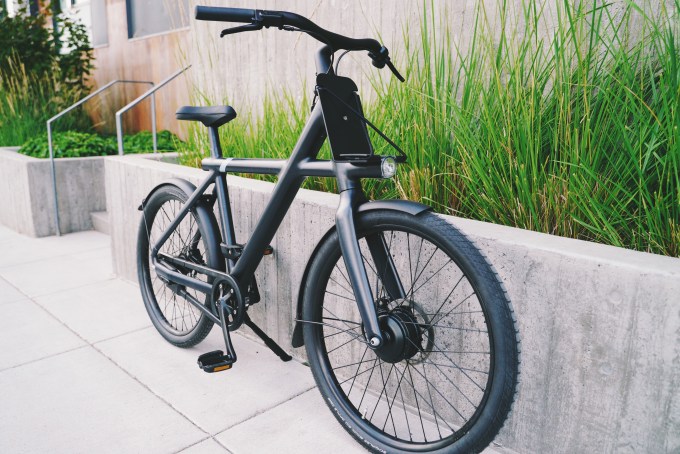
Before testing the X3, I’d find excuses to drive short distances instead of riding my bike. What if I got tired and didn’t feel like biking home? What if it starts pouring rain? What’s if it’s too hot? What if I’m too sweaty when I get to the office? Riding an e-bike erases most of those concerns outright.
The X3 is an effortless enough ride that I can still zoom to work if it’s 95+ degrees out. It’s fast enough that I can get out of a surprise rainstorm quickly if need be. If I don’t want to be sweaty at the start of the day, I can lean on sweet, sweet electricity to whisk me away, rolling up to my office without breaking a sweat. And it can’t go unstated that going fast on a bike — the whole time, with as much or little effort as you feel like putting in — is really, really fun.
VanMoof’s handsome pair of high tech bikes, the X3 and its larger cousin the S3, are far from the only options on the market, so some of their pluses would hold true for any electric bike. But that doesn’t make the VanMoof interchangeable either. The VanMoof X3 has a very specific look, feel and feature set that will perfectly suit a certain kind of rider (myself included) but other e-bike shoppers will still want to play the field. We’ll get into that — here goes!
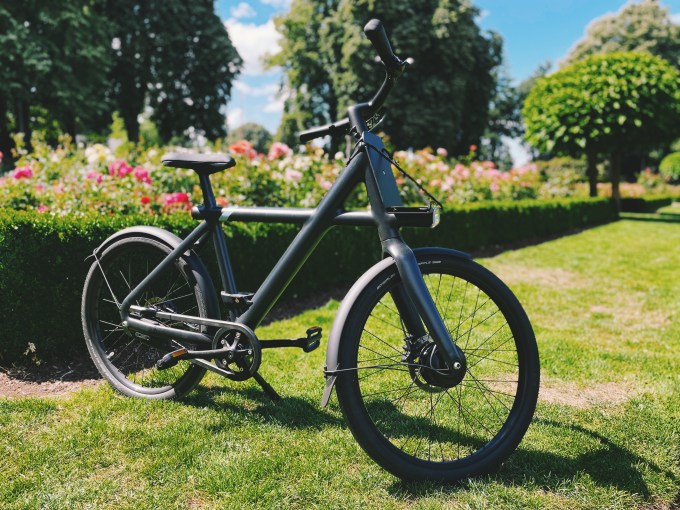
VanMoof X3 in the city of roses.
APPEARANCE
I tested the VanMoof X3 over the S3 not by choice — its geometry is a little wacky looking in pictures — but because I’m 5’4″. The X3, which fits anybody from 5′-6’5″, is a little smaller and less traditional looking than the S3, which suits anyone taller than 5’8″. The X3 has 24″ wheels rather than the S3’s 28″ wheels and it has a little bungee-corded platform in the front where presumably you could carry something, but I still have no idea what (You can also buy an add-on front basket that slots in there and looks very cute.)
Like most e-bikes, the X3 is much, much heavier than a normal road or commuter bike. The listed weight is 45.8 lbs and you’ll feel every pound of it if you ever need to carry it very far. I live in a standalone house in Portland, Oregon and had to carry the X3 down a very short front step to ride it — totally fine!
I used to live in a fifth floor walkup in Brooklyn and carrying it up or down that would have been impossible. If you can’t store the X3 (or most any e-bike) around ground level with access to a charger, it might not be a good fit for you. (Note that in our pictures, the small platform above the chain area is where an optional external battery pack, discussed later, sits. The platform is removable.)
Though on paper I’d prefer the look of the S3, the X3 doesn’t look strange at all IRL, whether parked or with somebody riding it. It’s cute, futuristic but not conspicuous and gets plenty of compliments. My wife described its aesthetic as “Death Star chic” and while I don’t totally know what that means, she’s not wrong. On the way to my office a sanitation truck driver rolled down his window to bellow “HEY—THAT’S A REALLY COOL BIKE.” Thanks, my dude!
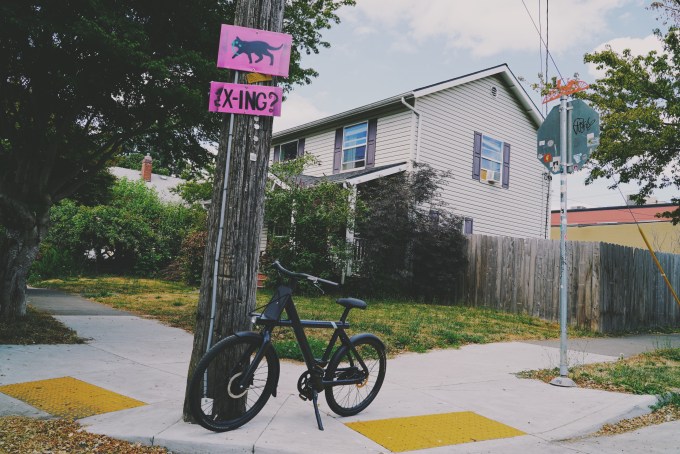
The current generation of VanMoof e-bikes are coated in matte paint and you can choose between a classic, sexy matte black or a pleasantly cheery matte light blue. A previous version of the bikes used glossy coating, but apparently the matte is supposed to be more scratch resistant. The paint does seem pretty tough though it’s not totally bombproof. Somehow the handlebars picked up a little nick in the paint, though I still have no idea where it came from or what did it (owls?).
Something important to note is that neither the VanMoof X3 or S3 look like e-bikes. They don’t have an ugly bulge jutting out from the frame and the top tube and down tube are both thick but uniform — and not so thick you’d think twice about it.
The electronic components are nestled away in the frame and even the drivetrain is tucked away and enclosed. And while there’s a deeply cool LED matrix display embedded in the top tube, only the rider really sees it. For anyone looking for an e-bike that doesn’t scream e-bike!!!! the VanMoof is one of the best choices if not the best choice you could make. It’s an awesome looking bike — not just an awesome looking e-bike.

Matrix display shows battery life, speed and other key info.
RIDING
The VanMoof X3 is a nice-looking bike — you get it. But what about, you know, the biking? I can confidently report that from the first time you hop on it to your twentieth commute to work, the X3 is an absolute joy to ride.
As an e-bike newcomer I had reservations. Would the electric assistance cheapen the magic of riding a bike? Do I really want a bike doing the shifting for me? As it turns out, quite the opposite and yes, absolutely.
The VanMoof X3 (and its sibling the S3) give you an electric boost while pedaling — you’ll still be pedaling but it feels enticingly easy and you’ll go faster with less effort. The bike also features a Turbo Boost button on the right-side handlebar that gives you a big boost on top of the smoother normal electronic assistance, up to 20 miles per hour in the U.S.
You can choose the amount of help that you want. Using the VanMoof app, which we’ll get to, or a physical button, you can select what level of power assist you’d like from zero to four. Zero is you pedaling a heavy-ass bike alone with no help (it sucks) and four makes everything feel so easy there’s almost no way to break a sweat.
In my time testing the bike, I’d use “two” when I felt like getting a bit of a workout with extra pep in my pedal, four when I was in a hurry to get to my co-working space in the mornings and three the rest of the time, like riding to brunch on a weekend. Being able to choose the level of pedal assistance is a huge perk and it makes the bike feel flexible for different uses.

The kick lock button, back wheel and enclosed chain.
Whatever mode you’re on, the turbo boost button is a killer feature. It flattens steep hills and makes it feel way safer to zip across busy intersections where you’re not sure drivers are paying attention. It’s fun and awesome for safe, defensive city riding.
It takes a little bit to get used to the automatic electronic shifting but that’s silky smooth too. I initially assumed that, like many things that worked perfectly well before having some extraneous “smart” high-tech nonsense draped over them (fridges! lamps! vibrators!) the technology would fail just often enough to be a nuisance.
After a long period of testing, I can report that the X3 rides as smooth and seamless as ever. Every once in a while I’d crunch down on the pedal or a gear won’t catch right away but it’s super rare. You can even use the app to customize when the bike shifts up and down and it’s worth playing around with that to find something that feels just right.
What else? The X3’s maximum assisted speed is in the U.S. is 20 mph (32km/hr), but anyone in Europe will be limited to 15.5 mph (25km/hr). The U.S. speed feels great and it’s painless to get up to 20mph and maintain that speed with the X3 in a way I’d have to destroy my quads to manage otherwise, even on my zippy non-electric road bike.
Beyond that, the seat is very comfy and the ride is pleasantly upright and natural. After riding the X3 for a while I had a hard time going back to hunching over on my (adorable) little Bianchi and pined for the comfy ride I’d gotten so used to.

Tail light from the future.
VALUE
The VanMoof X3 is an excellent value, all things considered. The company has a weird habit of tinkering with its pricing, but after a redesign and a colossal price drop in 2020 ($3,398 to $1,998 at the time) the bikes feel very well priced. Now they’re retailing for $2,298 — $300 more than the previous price but still a fine deal for anyone looking for a very full-featured e-bike without spending more than around $2,000.
That’s not very much more than you’d spend on a regular bike, sans electricity and many, many cool bells and whistles. And if you’re into higher end bikes, it could even be a lot less. It’s also substantially less than the high end of e-bike competition, which the VanMoof bikes feel like they compete with, even with the wallet-friendlier price tag.
Still, it’s kind of stressful that VanMoof is quietly messing around with the pricing with the bikes already out in the wild. It would suck to plan to buy one only to see the price shoot up before you’d pulled the trigger.
The company should be more transparent about this, giving set future dates for planned price changes. There also seem to be updates within generations of the bikes, so an X3 you buy now might differ from an X3 you could buy in 2020. That’s confusing and all of it should be made clearer somewhere obvious on the website.

The VanMoof app’s in-app ride tracking and summary stats.
RANGE
One of the biggest considerations with an e-bike (or an e-anything!) is range. VanMoof says the X3’s range is 37 miles using “full power” and up to 93 miles in economy mode. If you’re getting 93 miles out of the battery, you probably aren’t even using the pedal assistance at all, so you can just toss that number out. The low end estimate of 37 miles might be a little generous for someone who’s using the bike on the fourth power assistance level and smashing the turbo boost regularly, but 35-45 miles feels about right from my testing (usually mode 3 or 4, occasionally 2, light use of turbo button).
The range feels good. Even using the X3 most days out of the week, charging is infrequent enough to never feel annoying. In my case, that meant daily short rides (2.5-5 miles, usually) and the occasional longer ride (10-20 miles). If you’re using the X3 or S3 to commute to work somewhere that’s farther away, you’re going to find yourself plugging in more. Even so, I never got into a situation where I was concerned that I’d run out of battery far from home. And even if you do, you can still pedal the bike — it’s just really heavy. Most people will probably charge up overnight, but you can fill up the battery in four hours if you need to.
Something to note is that you’ll plug in a wall charger directly to the bike to charge it. For anyone who can’t charge and store the X3 on ground level, know you’ll have to carry the whole dang bike to an outlet. The lack of a removable battery might be a strike against the VanMoof bikes for folks who live in walk-ups or small apartments, but for people with somewhere easy to store it, this wasn’t something I thought twice about.
While the built-in range is totally adequate for a lot of use cases, VanMoof just introduced an external add-on battery pack for both the X3 and S3. The battery slots into a little platform, pictured below and mounted on our test bike, and it extends the X3’s range considerably. VanMoof sells the PowerBank accessory for $348. The thing isn’t small — it weighs six pounds — but VanMoof says it’ll give you anywhere from 28 to 62 miles of extra range. Again, almost nobody is going to hit the high end of this, but even at the low end it almost doubles the bike’s existing range.

External PowerBank via VanMoof
The PowerBank is big and pretty clunky. It doesn’t look awful, but it definitely makes the X3 look like an e-bike. It’s not elegant like the removable battery on the Cowboy, another extremely handsome e-bike, but it’s ok. If everything else about a VanMoof suits you perfectly but you need more range, it’s great to have the option, even if you’ll be shelling out for it.
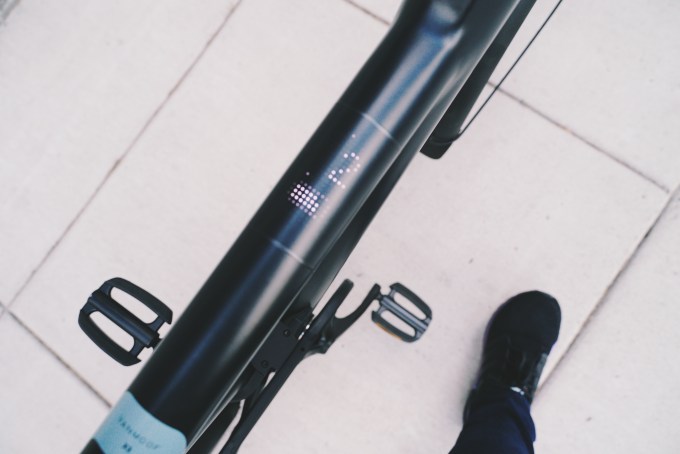
TECH FEATURES
The tech bells and whistles are something that really makes the VanMoof X3 and S3 stand out from the crowd. The X3’s price feels reasonable for a reliable, great-looking e-bike, but on top of that you’ll be getting an electric steed with some pretty sweet tricks. I’ll list them!
- Matrix display: On the bike’s top tube an array of LED lights built into the metal displays your speed, battery life and other useful info. This is a killer feature, it’s extremely cool!
- Alarm. You can activate an alarm that will *literally growl* at anyone who jostles your bike. It’s intense and really loud.
- Kick lock. You can kick a small physical button to alarm the bike and lock the back wheel. If you live in a city with bike theft, someone could still toss the bike in a truck easily so this isn’t a single security solution (use a normal lock!)
- Find My on iOS. If you’re an iOS user you can track your bike’s whereabouts easily. It’s a nice feature, though ideally if your bike is well-locked you aren’t going to be messing with this much.

VanMoof support for “Find My” app in iOS
- Lights. The VanMoof X3 has great built-in lights, front and back.
- App: Surprisingly, the app is actually pretty good. You can customize lots of small things (bell noise, alarm on or off, shifting preferences), use it to track your rides and more. You also don’t have to be connected to the bike with the app to do the most essential stuff, liking riding it, unlocking it and changing your level of electric assistance. I had an occasional connectivity problem with the app (usually on Android) but this was easily resolved and never kept me from biking anywhere, though it did mean some rides weren’t automatically tracked.
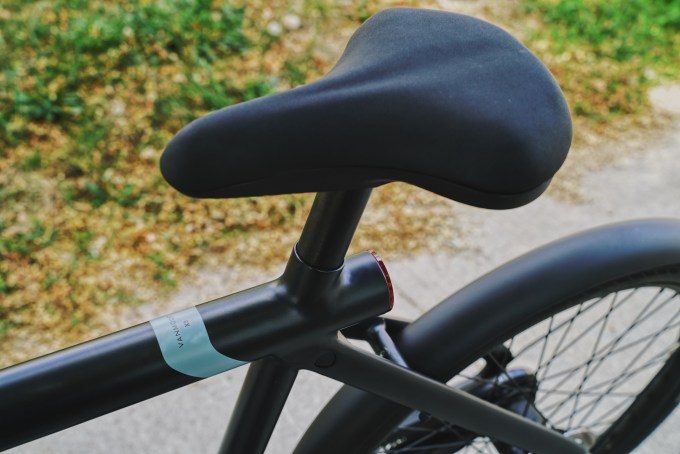
Overall, something great about the X3 is that the tech features aren’t just fancy tricks — they really enhance the experience. And even so, they’re optional. You can ride the bike and benefit from the power assistance without using the app. You can use a regular lock and skip the alarm system if you choose to, or use a physical button code to disable it manually. You can change the power assistance mode with the same button. This is all huge and lets you use the e-bike how you want to. Personally, I’d never buy an e-bike that required connectivity, a phone or an app to operate it; that’s just asking for trouble.
OTHER CONSIDERATIONS
Shipping and Assembly: The VanMoof X3 and S3 come in the mail in a big box. The assembly process was almost painless — except for this one really fiddly bit you have to slide into another fiddly bit which took me the better part of an hour and some searching on the VanMoof subreddit (not the only one with this problem!)
Extra Support: VanMoof offers three paid plans to keep your bike in working order and in your possession. You can buy a three-year maintenance plan for $348, a three-year theft recovery plan for $398 or a combined plan for $690 (broken down via VanMoof below).
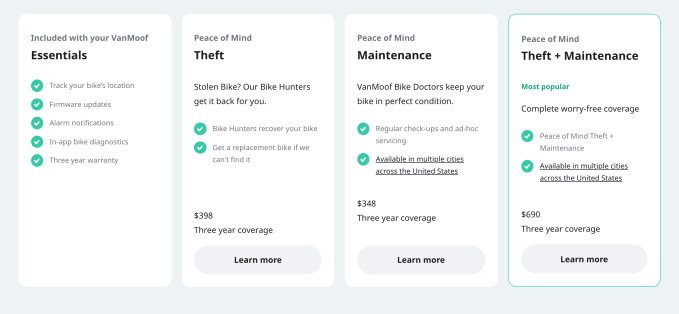
Maintenance: Where you live should be a major consideration when thinking about buying a VanMoof. In my time testing it for reliability over an extended period, I was surprised at how few problems came up. I had to mess around with re-centering the front wheel at some point because a brake pad was rubbing, but aside from occasional app connectivity issues, that was pretty much it. Of course, significant wear and tear means any bike could benefit from a pro tune up from someone who knows the model.
VanMoof has full-fledged stores in Amsterdam, London, Paris, Berlin, New York, San Francisco, Seattle and Tokyo. Beyond its flagship stores, the company relies on an expanding network of service centers and “certified workshops” to maintain its bikes, so be sure to check what’s near you. Personally, I’d want to be near enough to a VanMoof store or at least a service center to guarantee my $2,000+ investment and its many, many technological bits could be maintained in perfect health. Nobody wants to ship a bike back for repairs, especially this one.
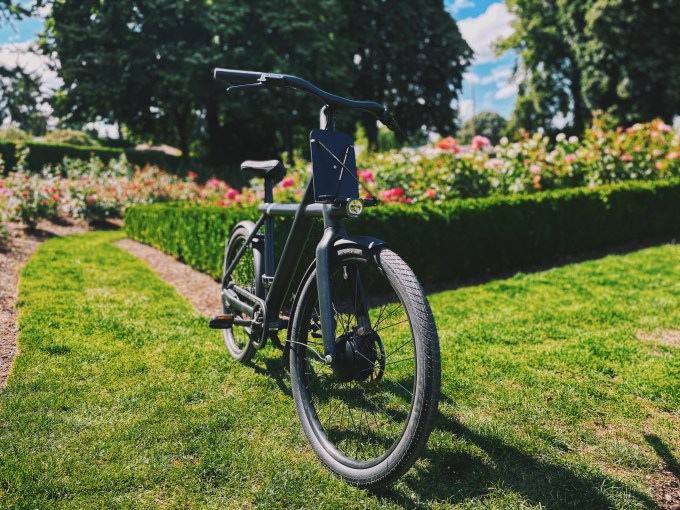
Prior to testing out the X3, e-bikes aren’t something I’d thought a lot about. I first heard of VanMoof a couple of years ago when a close friend and much more serious biker than me bought one for towing her dog (the goodest girl) on a long work commute. We rode to the farmer’s market together and her bike looked very cool, but I was skeptical that something with so much technology under the hood could prove reliable over time.
Bikes are mechanical and simple — that’s something wonderful about them! Could an e-bike really translate the joyful simplicity of biking into something much more high tech? As it turns out, yes. After test riding the VanMoof X3 to get a sense of its reliability over time and how its features hold up in normal day-to-day use, I regret my early skepticism.
I don’t know if I can overstate how much riding an e-bike, specifically this e-bike, has enhanced my life in small ways for the better. I feel happier and healthier, transitioning out of the intensely sedentary pandemic period into daily habits and outside activities that make me feel more connected to the world around me. I’m seeing my city with fresh eyes, biking to new neighborhoods I’ve never explored and appreciating all of the little things I took for granted. My only e-bike regret is not hopping on one sooner.





















